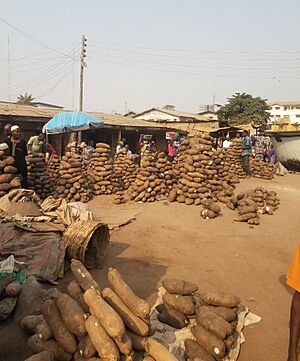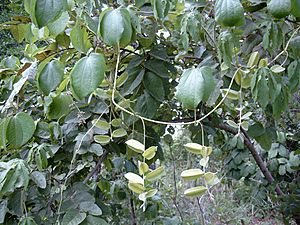Yam production in Nigeria facts for kids
Nigeria is the biggest producer of yams in the world. It grows over 70% of all yams globally. In 1985, Nigeria produced 18.3 million tonnes of yam. By 2008, this amount had almost doubled to 35 million tonnes! To give you an idea, the next biggest producers, Côte d'Ivoire and Ghana, only grew 6.9 and 4.8 million tonnes in 2008. The International Institute of Tropical Agriculture says Nigeria produces about 70% of the world's yams.
Yams are a root vegetable and a main food for people in Nigeria and West Africa. They give about 200 calories of energy per person each day. In many places where yams are grown in Nigeria, people say "yam is food and food is yam." This shows how important it is! However, Nigeria doesn't produce enough yams to meet everyone's needs. Yams also have a special social meaning in gatherings and religious events. The more yams a person has, the higher their social standing.
Contents
Types of Yam Grown in Nigeria
Yams belong to a plant group called Dioscorea. There are about 600 different types of yams. Six of these are very important for food. The most common and important types in Nigeria are:
- Dioscorea rotundata (white guinea yam)
- Dioscorea alata (water yam or purple yam)
Other types include:
- Dioscorea bulbifera (aerial yam) - grown mainly for its bulbils (small yams that grow on the plant stem)
- Dioscorea dumetorum (trifoliate yam)
- Dioscorea esculenta (lesser yam, Chinese yam)
Yams grow well in different parts of Nigeria. You can find them in coastal areas, rain forests, and savanna lands.
Other Root Vegetables in Nigeria
Besides yams, Nigerians also eat other root vegetables. These include:
Where Yams Grow Best in Nigeria
Yams are grown all over Nigeria. However, the Benue State is known for growing the most yams. This state is even called the "Nigerian Bread Basket" because of its high yam production. In Benue, especially among the Tiv people, the size of a farmer's yam farm or how many yams they grow shows their social status.
Farmers plant yams on mounds or ridges, not flat ground. This depends on the soil type, which is usually loose and good for root crops. A study found that growing yams in wetlands is more efficient than in uplands. Experts suggest growing more yams in wetlands. They also recommend using a new method called "yam minisett technology." This method helps grow more yams from smaller pieces of yam.
The Zaki Ibiam International Yam Market in Benue State is the largest market in Nigeria for a single product.
How Farmers Grow Yams
Yams need sandy, fertile soil that drains water well. Farmers prepare the land by making mounds or ridges about 1 metre (3 ft 3 in) high. The best yams for these conditions in Nigeria are white yam (Discorea rotundata) and water yam (Discorea alata).
Farmers plant small pieces of yam called "seed yam" or "cut setts." Before planting, they treat the yam pieces with wood ash or a special powder called a fungicide. This helps protect them from damage in the soil. The pieces are planted about 15–20 centimetres (5.9–7.9 in) apart, with the cut side facing up.
It's important to cover the soil around the plants with dry grass or plant bits. This is called mulching. It helps keep the soil moist. Farmers also add fertilizer if the soil needs it. They remove weeds by hand three or four times as the yams grow.
Yam plants need support to grow tall. Farmers use two stakes, each about 2 metres (6 ft 7 in) high, for every two plants. In the savannah areas, they also use Sorghum stalks for support.
To keep pests and diseases away, farmers use different methods. Pests like nematodes (tiny worms) and insects such as yam shoot beetles can harm the plants. Farmers also make sure to keep a 2–3 metres (6 ft 7 in – 9 ft 10 in) area around the field free of weeds. Using yam types that naturally resist diseases is also a good idea.
Farmers harvest yams before the plant leaves dry out and the soil gets too hard. White yams usually produce about 10–15 tonnes per hectare. Water yams can produce even more, about 16–25 tonnes per hectare. After harvesting, yams are tied with ropes and stored. They can last for about 5 months. Storage places should be safe from rodents and have good air flow. Any rotten or sprouted yams should be removed.
How People Use Yams
The main part of the yam plant is the tuber, which is the part that grows underground. Yam tubers have a lot of carbohydrates, which give you energy. They are low in fat and protein. Unpeeled yams also have vitamin C.
Yams taste a little sweet. People eat them in many ways. They can be boiled and eaten as a cooked vegetable. They can also be fried in oil. A very popular way to eat yam in Nigeria is to boil it and then pound it into a thick paste called fufu. This paste is often eaten with soup. Yam can also be made into flour, which is then used to prepare the paste.
Yams are also used in traditional medicine. Some people believe they can help the heart because they contain natural chemicals called alkaloids. Yam starch can also be used in industries, similar to starch from grains.
Yam Festivals and Traditions
Yams are so important that they are part of special rituals and festivals in southeastern Nigeria. Every year, there is a yam festival to celebrate the yam harvest. Village chiefs and important leaders who grow yams have a religious practice: they do not eat new yams until they have been offered to their gods. During this festival, villagers pray and thank their ancestors for good harvests and for women's fertility. The festival often includes parades with traditional dances.
Yam Customs in Marriage
In some Nigerian communities, there are interesting customs related to yams and marriage. One tradition is that a groom's wealth is measured by how many yams he can produce. The groom traditionally has to give at least 200 large yams to his future in-laws. This shows that he can take care of his wife and their future family.
In some parts of Igbo land, yams are seen as a male symbol. Another custom is that women are not allowed to go to the yam farms until the yams are ready for harvest. However, harvesting the yams is usually done by the women.
Images for kids









